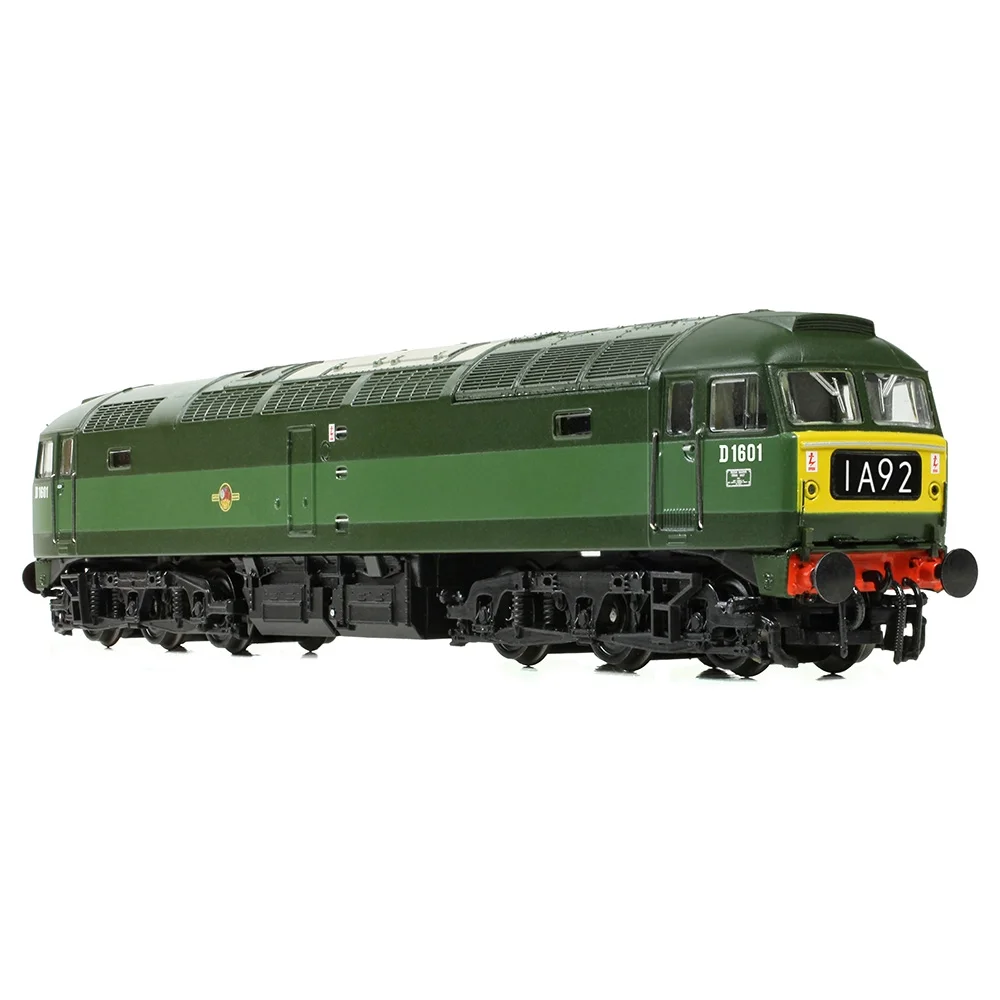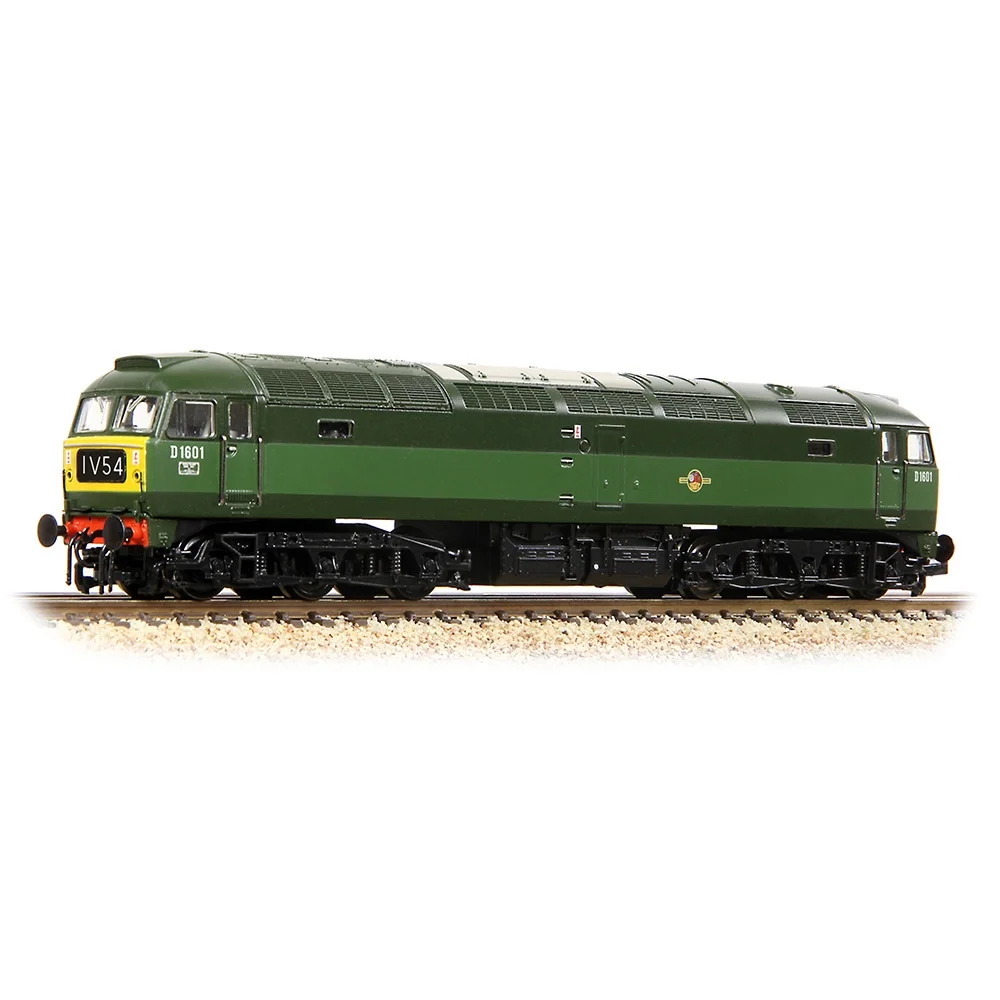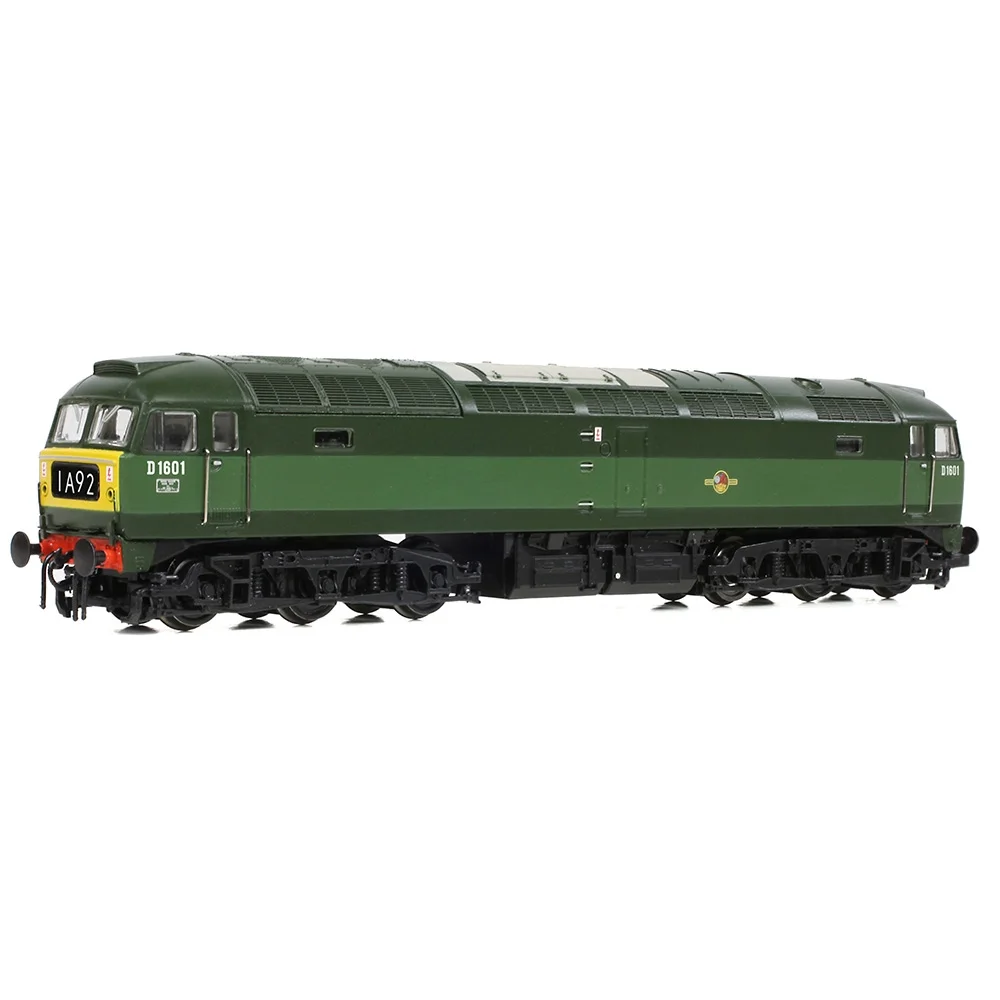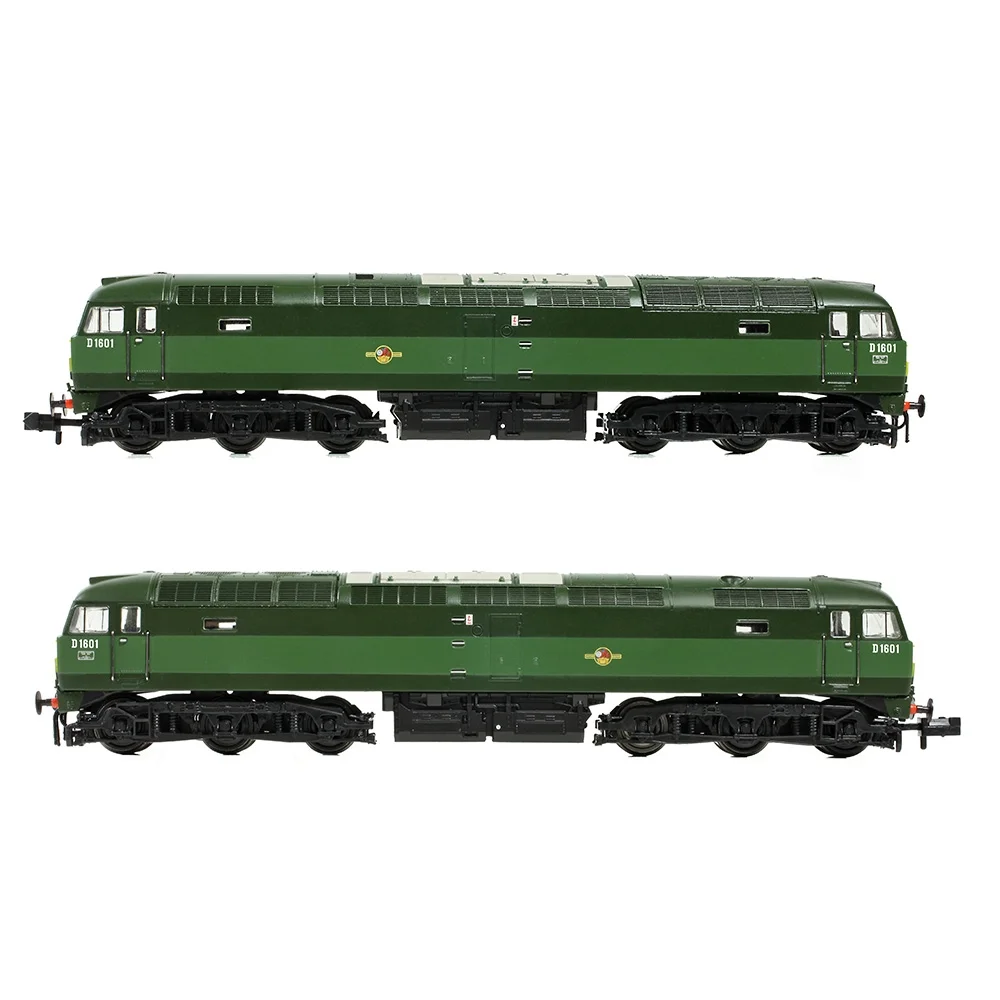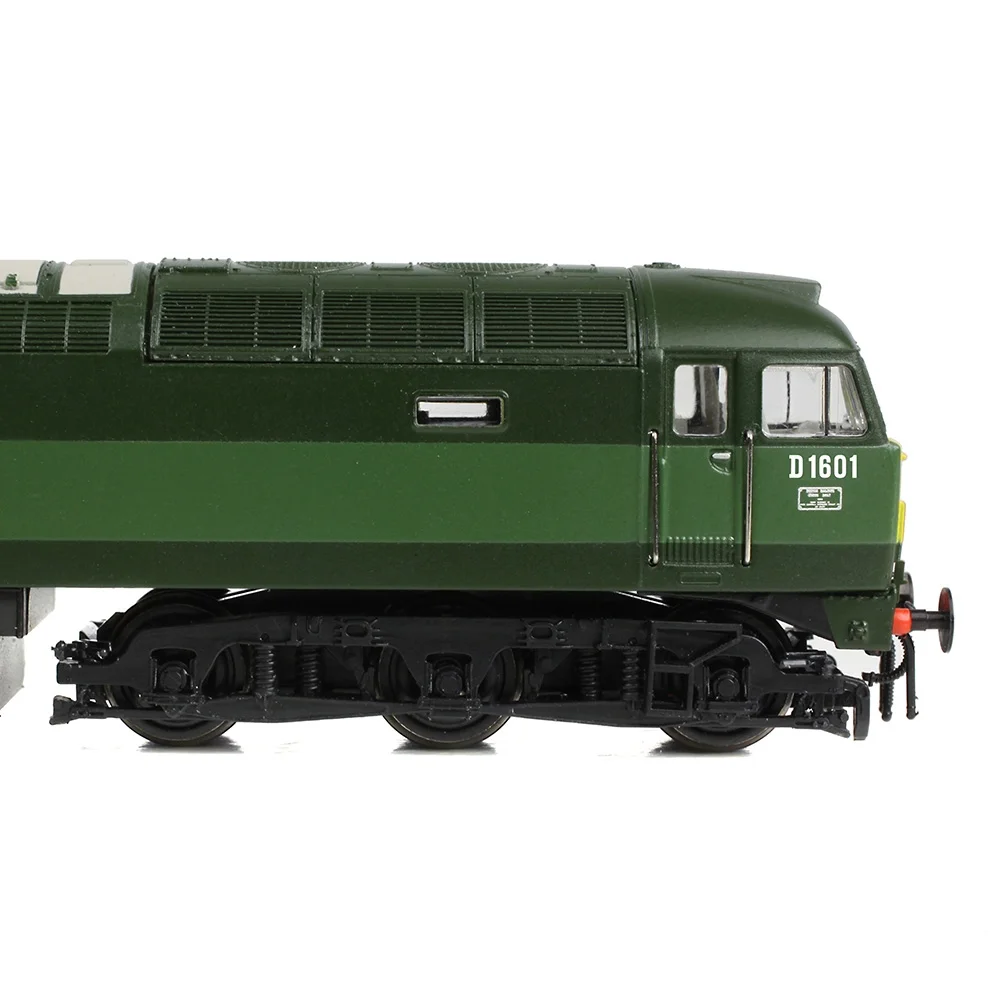Graham Farish 371-825ESF
British Rail Class 47/0 D1601 British Railways Green with Small Yellow Panels
Graham Farish's Description & Specifications
The Class 47 was British Railways’ most prolific class of main-line diesel locomotive and so it’s no surprise that high fidelity models of these ever-popular machines are available in N Scale as part of the flagship Graham Farish range.
This model tells the story of the Class’s early days of service, sporting original features and carrying the iconic two-tone green livery in which the majority of the fleet was outshopped, complete with small yellow warning panels at either end.
D1601 takes full advantage to the recent upgrades that have benefited the Graham Farish Class 47, namely the technical advancements which see the model boasting a Next18 DCC decoder interface, pre-fitted speaker, cab lighting (when used on DCC) and independent control of the directional lights at each end. The Next18 interface and pre-fitted speaker are put to full use in this SOUND FITTED model, bringing an added dimension to your model railway straight out of the box!
- Graham Farish N Scale
- Era 5
- Pristine BR Green (Small Yellow Warning Panels) livery
- Running No. D1601
- SOUND FITTED – Fitted with a ESU Loksound V5DCC Sound Decoder
- Length 139mm (over couplings)
DETAIL VARIATIONS SPECIFIC TO THIS MODEL
- Glazed Headcode Panels Displaying Blinds 1V54 and 1A92
- Twin Arm Windscreen Wipers
- High Intensity Headlight
- Round Buffers
- Bodyside Step below Cab Door
- Full Cab Roof Vents
- Original Three-Piece Radiator Grilles
- Ribbed Exhaust Panels
- Spanner Mk3 Roof Boiler Port
- 1,250 Gallon Water Tanks with Water Chutes
- Open Bogie-mounted Cab Steps
GRAHAM FARISH CLASS 47 SPECIFICATION
MECHANISM:
- Coreless, twin shaft motor with two flywheels providing drive to both bogies
- All axle drive
- Electrical pickup from eight wheels
- Diecast metal chassis block
- Gearing arranged for prototypical running speeds and haulage capabilities
- 9mm (N gauge) wheels to NEM310 standards with authentic profile and detailing
- Bogie-mounted coupling pockets to NEM355 standards at each end
- Designed to operate on curves of second radius (263.5mm) or greater
DETAILING:
- Bogies constructed from multiple components featuring full relief detail
- Separately applied detail parts, including lamp irons, cab handrails and roof aerial (where applicable)
- Separately fitted battery box/water/fuel tank assembly
- Cab Interior Detailing
- Each model supplied with a full set of model-specific bufferbeam pipework and accessory parts
LIGHTING:
- Directional lighting, switchable on/off at either end on DCC or Analogue control
- Cab lighting, switchable on/off (when used on DCC only)
- Authentic light colours and temperatures selected for each model based on era and application
DCC:
- Next18 DCC decoder interface
SOUND:
- Speaker installed in all models for optimum sound reproduction
- ESU Loksound V5DCC Sound Decoder fitted to SOUND FITTED versions
- Sound files produced specifically for the Graham Farish Class 47 using recordings from real locomotives
- SOUND FITTED models operate on DCC and Analogue control as supplied
LIVERY APPLICATION:
- Authentic liveries applied to all models
- Multiple paint applications employed on each model using BR/TOC specification colours
- Logos, numerals and text added as appropriate using multi-stage tampo printing using authentic typefaces, logos and colours
Class & Prototype
- Class: British Rail Class 47/0
- Traction: Diesel
- Transmission: Electric
- Built: 1962-1965
- Total Built: -
The British Rail Class 47, or Brush Type 4, built 1962-1968, represents Britain's most numerous mainline diesel with 512 locomotives constructed by Brush Traction and BR Crewe Works. Despite early reliability problems, a mid-1960s decision to derate engines from 2,750 to 2,580 bhp transformed the class into Britain's most dependable mixed-traffic locomotive, achieving 55+ years service. Operating across all BR regions hauling everything from royal trains to coal hoppers, Class 47s wore over 30 distinct liveries spanning BR green through colourful sector schemes to privatisation colours. Currently, Bachmann and Heljan produce exceptional OO gauge models with motorised fans, ESU LokSound V5 sound, and 150+ detail parts, while Graham Farish dominates N gauge. With 32 preserved locomotives and continuing heritage operations, the "Duff" remains an iconic part of British railway heritage.
No prototype found.
Operator & Livery
- Operator: British Railways
- Livery: Green with Small Yellow Panels
British Railways transformed Britain's fragmented rail network into a unified national system following nationalisation on 1st January 1948. Created from the "Big Four" companies under the Transport Act 1947, BR operated most of Great Britain's railways until rebranding as British Rail in 1965, managing over 20,000 route miles and inheriting nearly 20,000 locomotives of diverse designs.
The organisation pioneered standardisation through its revolutionary BR Standard locomotive programme (1951-1960), producing 999 advanced steam engines under Robert Riddles' direction. These included the versatile Britannia Pacifics, mighty 9F freight engines, and mixed-traffic classes that incorporated the best features from all predecessor companies. The 1955 Modernisation Plan accelerated diesel and electric traction development, creating fascinating mixed-traction operations.
Notable achievements included establishing unified locomotive classification systems, introducing distinctive corporate liveries, and managing the complex transition from steam to modern traction. BR's six regional structure preserved operational diversity whilst enabling standardisation of practices, signalling, and rolling stock that had eluded private enterprise for over a century.
The BR era represents steam traction's final flowering alongside emerging diesel technology, creating unparalleled locomotive variety. Today, this heritage remains highly popular with railway enthusiasts through extensive preserved fleets, heritage railway operations, and comprehensive model ranges from manufacturers like Hornby, Bachmann, and Dapol, making BR subjects essential for authentic post-war British railway modelling across all scales.
British Railways' green livery with small yellow warning panels represented a significant safety evolution during the early 1960s, combining the established prestige of the Deep Bronze Green finish with new visibility requirements for locomotive operations. The basic livery remained the standard BS224 Deep Bronze Green used on express passenger steam locomotives, maintaining visual continuity across the modernising fleet whilst incorporating practical safety improvements mandated by changing operational practices.
The distinctive feature of this livery was the addition of small yellow warning panels to the lower portion of locomotive ends, initially introduced around 1960-1962 as BR began implementing enhanced visibility measures. These panels were typically rectangular and covered only the lower section of each cab front, leaving the majority of the end in the base green colour. Many locomotives in this livery also featured additional decorative elements including grey roofs, white cab window surrounds, and various stripe configurations - some had broad horizontal grey or light-coloured stripes at solebar level, whilst others featured narrow white stripes positioned at waist height along the bodysides.
This livery variant appeared across numerous diesel classes including the Class 24, 26, 27, 35 (Hymek), 46, and others during the early-to-mid 1960s transition period. The small yellow panels were later expanded to full yellow ends from around 1966-1967, making the intermediate period with partial yellow treatment relatively brief but historically significant. Locomotives carried either the early "Lion and Wheel" or later "Lion and Crown" crests depending on their painting date, positioned centrally on the bodysides. This livery represents BR's cautious approach to safety modernisation, gradually introducing visibility improvements whilst maintaining traditional railway aesthetics before the comprehensive Rail Blue revolution transformed the entire fleet's appearance from 1965 onwards.
